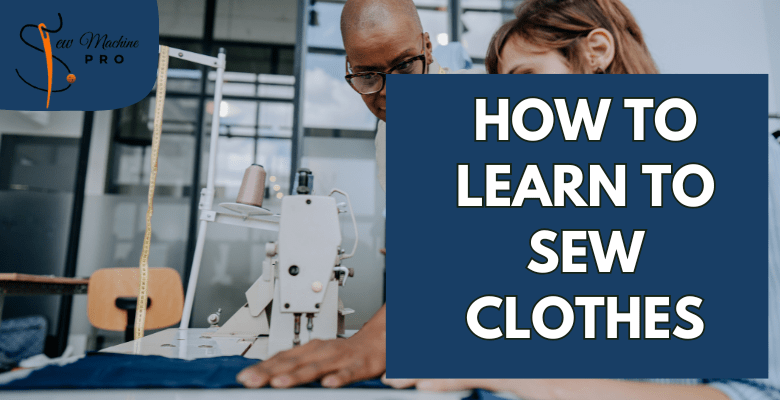
When starting a sewing learning journey every beginner raises questions like “Where should I start sewing?”, “How long will it take to learn?”, “Which fabric is best for beginners?”, “Do I need an expensive machine?”, and “Can I learn to sew at home?”. Considering these frequent inquiries, I’m deciding to write about this topic to make it easier for everyone and clear the concerns.
Tips That Will Greatly Benefit You! These sewing tips are designed to enhance your sewing skills and boost your confidence. Whether you’re just starting or looking to improve, following these tips will make your sewing journey smoother and more enjoyable. Ready to elevate your sewing game?
Get started now! Explore our collection of sewing topics, tools, and resources to master the art of sewing.
What is sewing
Sewing is a technique where fabric, textiles, or materials are joined using a needle and thread. There are different ways to sew, like by hand or machine.
- Garment construction (making clothes, dresses, etc.)
- Alterations and repairs
- Upholstery and home decor
- Crafting and embroidery
- Quilting and patchwork
Supplies You’ll Need to Learn to Sew Clothes
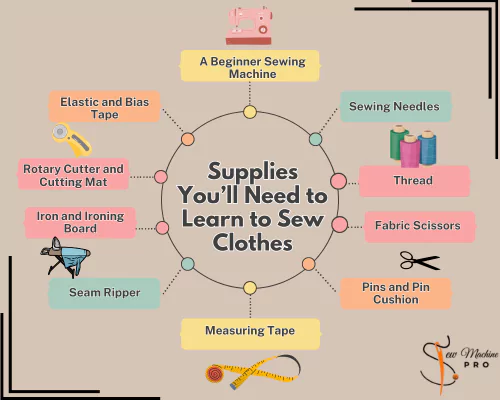
- A Beginner Sewing Machine
- Sewing Needles
- Thread
- Fabric Scissors.
- Pins and Pin Cushion
- Measuring Tape
- Seam Ripper
- Iron and Ironing Board
- Rotary Cutter and Cutting Mat
- Zippers, Buttons, and Other Fasteners
- Elastic and Bias Tape
Which Fabrics Are Used to Sew Clothes?
Start with fabrics that are easy to handle to sew clothes, as some are more beginner-friendly than others:
- Cotton
Cotton is sturdy, easy to sew, and perfect for everything from shirts to dresses. It’s also easy to cut and doesn’t slip around as much as more advanced fabrics.
- Linen
Linen is a lightweight and breathable fabric, making it ideal for summer clothing. It is also easy to handle and sew, especially for beginners.
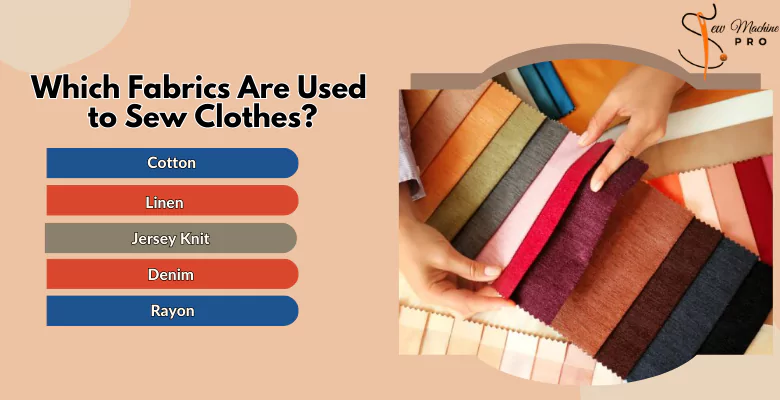
- Jersey Knit
A soft, stretchy fabric often used for casual clothing like T-shirts. Though a bit more advanced, a jersey is manageable once you get comfortable with stretch fabrics.
- Denim
Denim is thick and sturdy, making it perfect for structured garments like skirts and pants. It’s slightly more advanced, as thicker fabrics can be challenging to sew at first.
- Rayon
Rayon drapes beautifully but can be slippery to work with, making it more suitable for those who have some sewing experience.
Where to Start Learning to Sew Clothes?
Learning to sew clothes is a great skill to have. To start, you might want to consider the following steps:
- Get a Sewing Machine: If you don’t have one already, investing in a good sewing machine can make the process much easier and faster.
- Learn the Basics: Familiarize yourself with basic sewing techniques like threading the machine, sewing straight lines, making seams, and understanding different stitches.
- Take a Class or Watch Tutorials: You can enroll in a sewing class at a local community center or look for online tutorials on platforms like YouTube. These resources can help you learn different techniques and patterns.
- Start with Simple Projects: Begin with easy projects like sewing a pillowcase, tote bag, or simple skirt to practice your skills before moving on to more complex clothing items.
- Practice, Practice, Practice: Sewing is a skill that requires expertise like any other. Don’t be discouraged by mistakes; they’re a natural part of the learning process.
- Learn to Read Patterns: Understanding sewing patterns is essential for making clothes. Begin with simpler patterns and gradually go to more complex designs.
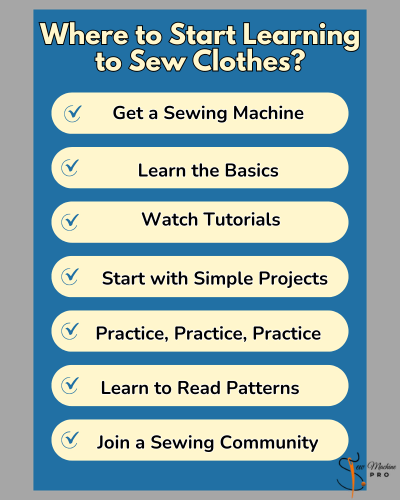
- Join a Sewing Community: Joining sewing forums or groups can provide you with support, advice, and inspiration from fellow sewing enthusiasts.
Remember, patience and practice are key when learning to sew. Enjoy the process and have fun creating your own clothes.
How to Cut and Sew Clothes: A Step-by-Step Guide
Sew your own style! This step-by-step guide covers fabric selection, cutting, and sewing techniques for both beginners and experienced step by step. Follow clear instructions, helpful tips, and expert insights to bring your fashion ideas to life and improve your sewing skills.“
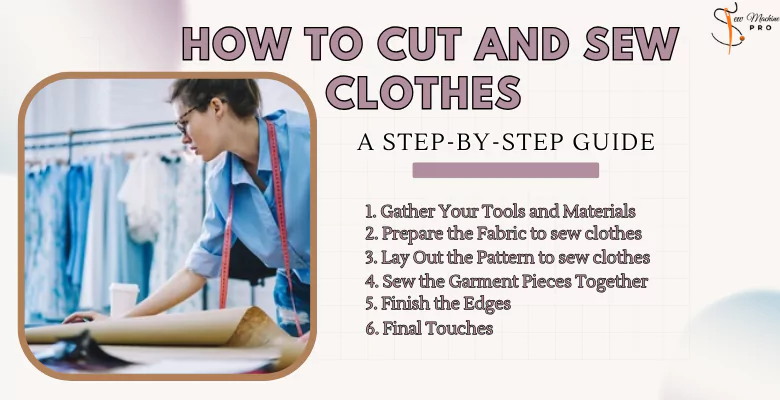
1. Gather Your Tools and Materials
Before you start sewing, ensure you have all the necessary tools and materials:
- Fabric
- Sewing Machine
- Scissors
- Sewing Pins or Clips
- Measuring Tape
- Chalk or Fabric Marker
2. Prepare the Fabric to sew clothes
- Wash and Iron the Fabric: Wash and iron your fabric before sewing to prevent shrinking and ensure accurate cuts.
- Lay Out the Fabric: Fold your fabric according to the pattern instructions, typically with the right sides facing together.
3. Lay Out the Pattern to sew clothes
- Place the Pattern Pieces on the Fabric: Pin or clip the pattern pieces to the fabric. Make sure you follow the grainline indicated.
- Arrange Efficiently: Place the pieces in a way that minimizes fabric waste. Pay attention to directional prints and patterns on the fabric.
- Take measurements: Take your measurements with a measuring tape, note down your size, and mark the measurements onto your fabric using chalk or a fabric marker.
- Cut Along the Lines: Use sharp fabric scissors to cut out each piece carefully. Keep the scissors perpendicular to the fabric to avoid jagged edges.
4. Sew the Garment Pieces Together
- Pin the Pieces: Start by pinning or clipping the pieces together, following the pattern instructions. This usually begins with the main seams, such as the sides and shoulders.
- Sew the Seams: Using your sewing machine, sew the pieces together along the seam allowances, typically 1/4 to 5/8 inches from the edge. Remove the pins as you sew.
- Press the Seams: Use an iron to press the seams open or to one side, as instructed by the pattern. Pressing each seam as you go makes the garment look more professional.
5. Finish the Edges
- Sew Finishing Stitches: Seal the deal! Finish raw edges with zigzag stitch or serger to lock in fabric integrity.
6. Final Touches
- Try It On: Test the fit of your garment. Make any necessary adjustments to ensure it’s comfortable and fits well.
- Press and Finish: Give the entire garment a final press to remove any wrinkles and set the seams.
Ready to Start Your Sewing Journey?
There’s no better time to start sewing than today! Whether you want to design your own clothes, make unique gifts, or simply enjoy a relaxing hobby, sewing offers endless rewards
7 Easy Projects to Kickstart Your Sewing Journey
Kickstart your sewing journey with these 7 easy beginner projects! Sewing is a wonderful hobby that offers creative expression and relaxation. For beginners, knowing where to start with sewing can be overwhelming. That’s why we’ve curated 7 easy projects to help you kickstart your sewing journey.
1. Tote Bag
A tote bag is one of the easiest and most rewarding projects for beginners. It’s a practical item that you can use daily, and it doesn’t require complicated skills.
2. Pillowcase
Pillowcases are a great project for getting comfortable with your sewing machine. They’re quick to make and perfect for adding a splash of color to your home.
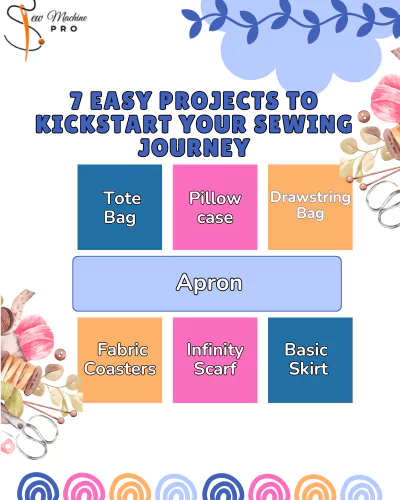
2. Pillowcase
Pillowcases are a great project for getting comfortable with your sewing machine. They’re quick to make and perfect for adding a splash of color to your home.
3. Drawstring Bag
A drawstring bag is not only easy to make but also incredibly versatile. Use it to store small items, as a gift bag, or even as a shoe bag for travel.
4. Basic Skirt
Once you’re comfortable with straight seams, try making a simple skirt. It’s a great way to dip your toes into garment sewing without complicated patterns.
5. Fabric Coasters
Fabric coasters are small, quick projects that can be made from scrap fabric. They’re perfect for practicing precision and make excellent gifts!
6. Infinity Scarf
An infinity scarf is a stylish project that requires minimal sewing. It’s a great way to practice sewing with knit fabrics, which are slightly stretchy and soft.
7. Apron
An apron is a functional project that helps you learn various sewing techniques in one go. It’s also an excellent gift for anyone who loves cooking or crafting.
